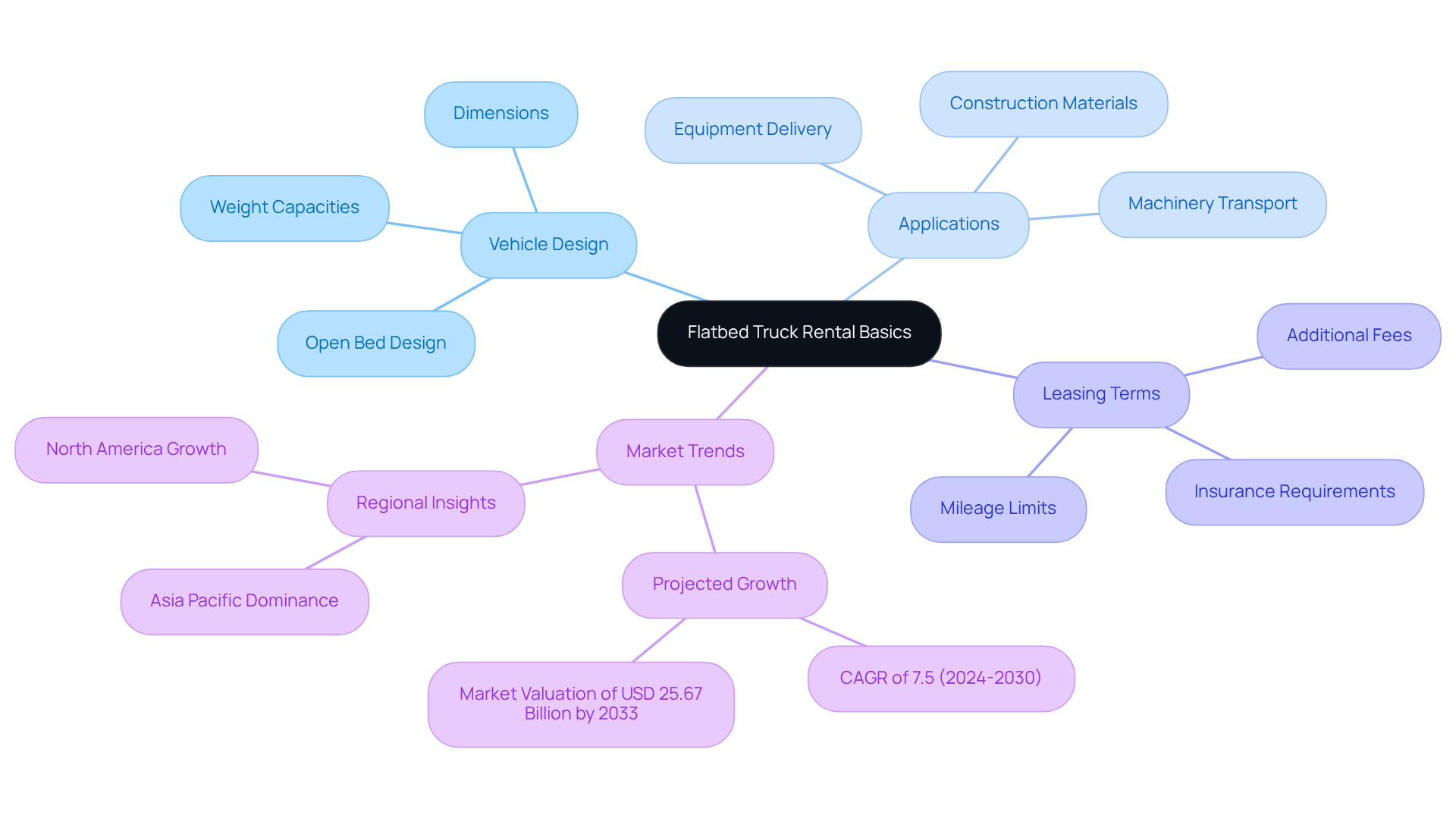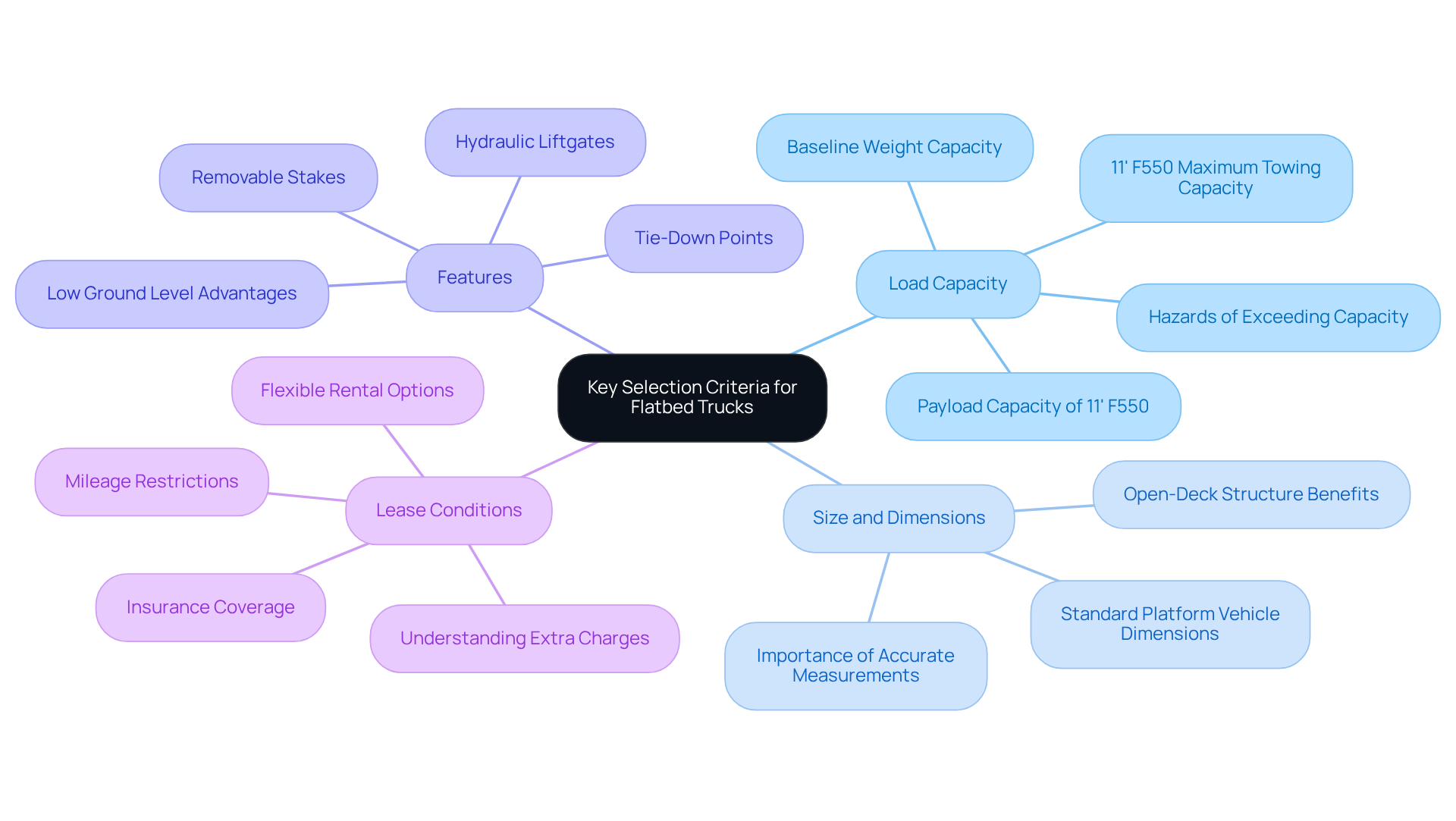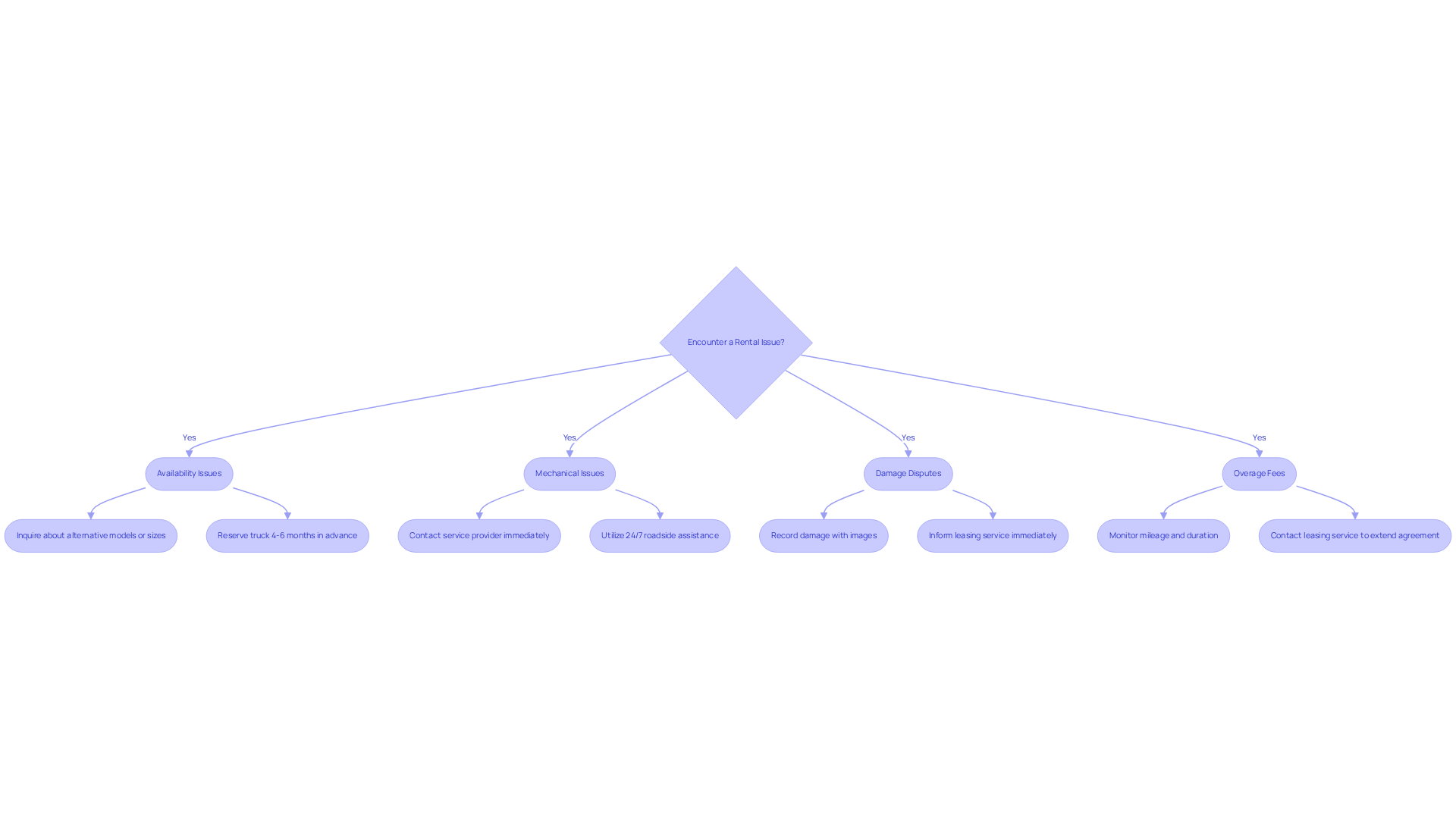Overview
To rent a flatbed efficiently, it is essential to follow four key steps:
- Research leasing firms
- Check vehicle availability
- Make a reservation
- Prepare the necessary documentation
Understanding leasing terms and conditions is crucial, as it ensures that you select the right vehicle based on load capacity and features. Furthermore, proactively addressing common rental issues can significantly enhance your rental experience, leading to a smoother process overall. This approach not only minimizes potential challenges but also maximizes the reliability and quality of your rental.
Key Highlights:
- Flatbed trucks feature a flat, open bed design, ideal for transporting large or awkwardly shaped cargo.
- Key applications include construction materials, machinery, and heavy equipment.
- Understanding leasing terms, including insurance and mileage limits, is crucial to avoid unexpected costs.
- The flatbed vehicle leasing market is projected to grow at a CAGR of 7.5%, reaching USD 25.67 billion by 2033.
- When selecting a flatbed truck, consider load capacity, size, features, and lease conditions.
- Key specifications include maximum towing capacities and payload limits, such as 30,000 lbs for F550 utility vehicles.
- Steps to secure a flatbed rental include researching leasing firms, checking availability, making reservations, and preparing necessary documentation.
- Common rental issues include availability, mechanical problems, damage disputes, and overage fees; proactive measures can mitigate these challenges.
Introduction
Navigating the world of flatbed truck rentals presents unique challenges, particularly given the rising demand for efficient logistics solutions. Selecting the right vehicle involves understanding critical factors such as load capacity and lease conditions, which are essential for transporting heavy or oversized cargo. With numerous options available, ensuring a seamless rental experience can seem daunting.
This guide outlines the key steps and considerations necessary for individuals and businesses to secure the ideal flatbed truck rental efficiently, helping to avoid common pitfalls along the way.
Understand Flatbed Truck Rental Basics
Flatbed vehicles are specialized machines crafted with a flat, open bed that lacks sides or a roof. This design facilitates easy loading and unloading of cargo, making them ideal for transporting large, heavy, or awkwardly shaped items. Typical applications for these open platform vehicles encompass construction materials, machinery, and equipment. Understanding the varieties of flat transport vehicles available, including those with different weight capacities and dimensions, is essential for selecting the suitable automobile for your needs. Additionally, it is important to familiarize yourself with leasing terms and conditions, such as insurance requirements and mileage limits, to avoid unexpected costs.
In 2025, average leasing expenses for platform vehicles in Texas are projected to reflect the growing demand for effective logistics solutions, with the vehicle leasing market expected to expand at a CAGR of 7.5% from 2024 to 2030. As the flat platform vehicle market continues to flourish, with a valuation anticipated to reach USD 25.67 billion by 2033, understanding leasing terms and conditions becomes increasingly vital. This includes being aware of insurance requirements, mileage limits, and any additional fees that may apply, ensuring businesses can avoid unexpected costs and optimize their rental experience.
Experts in logistics emphasize the critical role of open-deck vehicles in the construction and transportation industries, highlighting their adaptability and effectiveness in transporting heavy cargo. For example, General Motors has acknowledged the importance of payload capacity in their pickup vehicles, which enhances their utility in construction projects. Case studies illustrate how construction firms leverage open-platform vehicles to optimize operations, reduce downtime, and improve project delivery schedules. Familiarizing yourself with these rental fundamentals is crucial for making informed decisions and maximizing the benefits of vehicle rentals.

Identify Key Selection Criteria for Flatbed Trucks
When selecting a flat bed for rent, it is essential to consider several key criteria that will ensure a successful rental experience.
-
Load Capacity is paramount. Assess the weight of the items you intend to transport. For instance, the 11' F550 utility vehicles can tow a maximum of 30,000 lbs, with a payload capacity of 12,370 lbs. Additionally, the baseline weight capacity of platform vehicles is approximately 48,000 lbs. It is crucial to ensure that the vehicle's specifications align with your load requirements to avoid exceeding its weight limit, which is both hazardous and unlawful.
-
Next, consider the Size and Dimensions of your cargo. Accurately measure the dimensions to confirm that everything fits on the platform. Standard platform vehicles typically feature an open-deck structure, facilitating simple loading and unloading of various cargo sizes. Pay attention to the length, width, and height of your items to guarantee compatibility.
-
Additionally, evaluate the Features that may enhance your leasing experience. Look for options such as removable stakes, tie-down points, and hydraulic liftgates, which assist in loading and securing heavy or oversized cargo. The low ground level and step deck design of flatbed trucks, especially the flat bed for rent, provide advantages when navigating narrow roads or under small bridges, significantly improving transport efficiency.
-
Lastly, thoroughly examine the Lease Conditions outlined in the leasing agreement. Pay attention to specifics regarding mileage restrictions, insurance coverage, and any potential extra charges. Flexible leasing options are available, ranging from one day to two years, allowing you to select a plan that best fits your project timeline. Understanding these terms is essential to prevent unforeseen expenses and ensure a seamless leasing process.

Follow Steps to Secure Your Flatbed Rental
To secure your flatbed truck rental efficiently, follow these essential steps:
-
Investigate leasing firms by starting with identifying nearby leasing services that offer flat beds for rent. Assess their reliability and customer service through online reviews and ratings, ensuring you select a reputable provider.
-
Check Availability: Reach out to the chosen leasing companies to confirm the availability of the flat bed for rent that you require. Inquire about leasing fees, any current promotions, and the average lead time for bookings. During busy seasons, it is generally advised to book 2-3 months in advance to guarantee vehicle availability.
-
Make a reservation for the flat bed for rent after finding a suitable option. Provide key information such as the date of hire, duration, and any specific needs for the vehicle. Many vehicle leasing firms emphasize the importance of reserving in advance to secure your desired automobile. As Penske states, "Scheduling a vehicle at least 24 hours beforehand guarantees that the vehicle you booked is prepared on the lot."
-
Prepare Required Documentation: Collect all necessary documents, including a valid driver’s license, proof of insurance, and payment information. Understanding the lease contract is crucial, as it may include mileage restrictions and insurance stipulations that could impact your leasing experience. For instance, the average cost for a 100-mile move is approximately $131.37, an important consideration for budgeting.
-
Inspect the flat bed for rent: Prior to driving off, conduct a thorough inspection of the flat bed for rent for any pre-existing damage and ensure it meets your operational needs. Document any issues to prevent disputes upon return, fostering a smooth leasing experience. National ranks highest in overall customer satisfaction with a score of 736, making it a reliable choice for your rental needs.

Troubleshoot Common Rental Issues
When you opt for a flat bed for rent, you may encounter several common issues. Here’s how to troubleshoot them effectively:
-
Availability Issues: If your desired vehicle is unavailable, inquire about alternative models or sizes that may meet your requirements. Given that equipment availability can become scarce during peak seasons, it is advisable to reserve your truck well in advance—ideally 4-6 months ahead—to secure preferred rates and options. Early booking enhances negotiating power for rates and ensures access to preferred equipment, reducing the risk of limited availability and premium pricing.
-
Mechanical Issues: Should you encounter mechanical difficulties during your lease, promptly reach out to the service provider. Most reputable businesses offer 24/7 roadside assistance and can organize a replacement vehicle if needed, ensuring minimal disruption to your operations. Established protocols for immediate replacement or repair can significantly minimize potential cargo loss during critical periods, as noted by industry professionals.
-
Damage Disputes: If you observe any damage upon collection, record it carefully with images and inform the leasing service immediately. This proactive approach protects you from being charged for pre-existing damage, a common concern among renters. Sustaining open dialogue with the leasing service can clarify any damage-related concerns and foster a smoother rental experience.
-
Overage Fees: To prevent unforeseen charges, carefully monitor your mileage and duration of the lease. If you anticipate requiring the vehicle for an extended time, contact the leasing service as soon as possible to prolong your agreement. This can help you avoid costly overage fees, particularly high during peak demand periods. Companies that secure lease agreements early can navigate summer demand spikes more effectively, capturing market opportunities while minimizing costs.
By following these steps, you can navigate common rental challenges and ensure a smoother experience when opting for a flat bed for rent.

Conclusion
Renting a flatbed truck can be a straightforward process when approached with the right knowledge and preparation. Understanding the fundamentals of flatbed truck rentals—such as their unique features and the importance of selecting the right vehicle for specific cargo needs—sets the stage for a successful rental experience. This guide emphasizes the significance of being informed about leasing terms, load capacities, and the necessary documentation to streamline the process.
Key insights highlighted throughout the article include the critical selection criteria for flatbed trucks, such as:
- Load capacity
- Size
- Essential features that enhance usability
Furthermore, the outlined steps for securing a rental—ranging from researching leasing firms to inspecting the vehicle before use—offer practical guidance for avoiding common pitfalls. Addressing potential rental issues proactively further ensures a smoother experience, allowing for efficient logistics and timely project execution.
Ultimately, the importance of thorough preparation and informed decision-making cannot be understated in the flatbed truck rental process. By applying the strategies discussed, individuals and businesses can optimize their rental experience, minimize unexpected costs, and enhance operational efficiency. Embracing these practices not only facilitates successful transportation but also contributes to the overall effectiveness of logistics in various industries.
Frequently Asked Questions
What are flatbed trucks used for?
Flatbed trucks are used for transporting large, heavy, or awkwardly shaped items, such as construction materials, machinery, and equipment.
What are the key features of flatbed trucks?
Flatbed trucks have a flat, open bed that lacks sides or a roof, facilitating easy loading and unloading of cargo.
Why is it important to understand the varieties of flatbed trucks available?
Understanding the different types of flatbed trucks, including their weight capacities and dimensions, is essential for selecting the right vehicle for your needs.
What should I know about leasing terms and conditions for flatbed trucks?
It is important to familiarize yourself with leasing terms, including insurance requirements, mileage limits, and any additional fees, to avoid unexpected costs.
What is the projected growth of the flatbed truck leasing market in Texas?
The flatbed truck leasing market in Texas is projected to expand at a CAGR of 7.5% from 2024 to 2030, reflecting the growing demand for effective logistics solutions.
What is the anticipated market valuation for flatbed vehicles by 2033?
The flatbed vehicle market is anticipated to reach a valuation of USD 25.67 billion by 2033.
How do flatbed trucks contribute to the construction and transportation industries?
Flatbed trucks play a critical role in these industries by providing adaptability and effectiveness in transporting heavy cargo, optimizing operations, reducing downtime, and improving project delivery schedules.
How can businesses maximize their rental experience with flatbed trucks?
Businesses can maximize their rental experience by familiarizing themselves with rental fundamentals, including understanding vehicle specifications and leasing terms, to make informed decisions.




